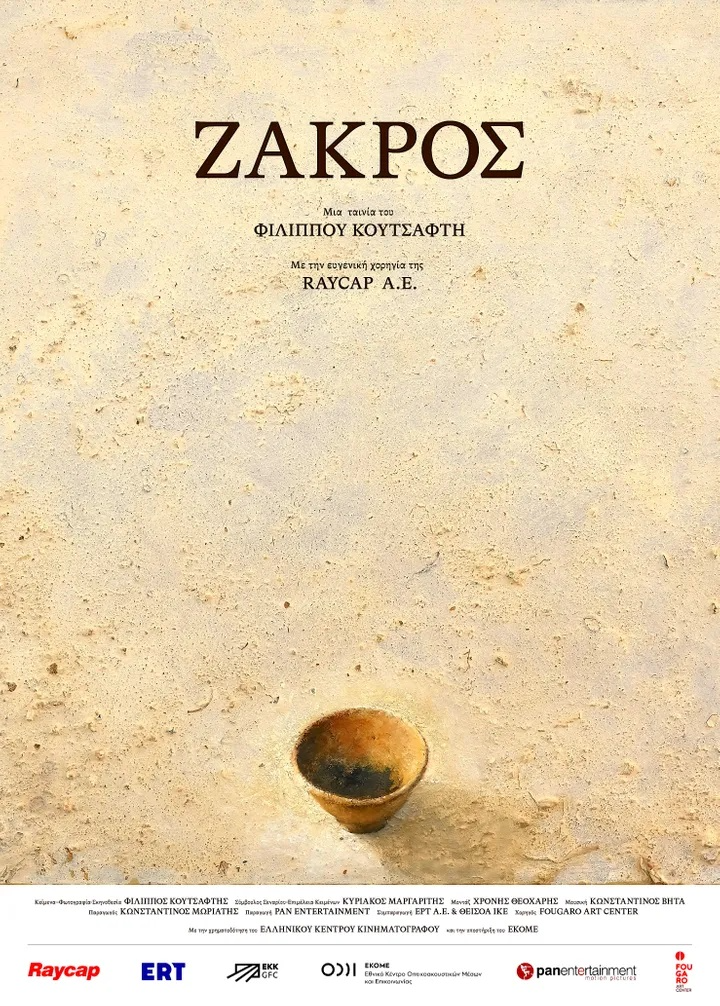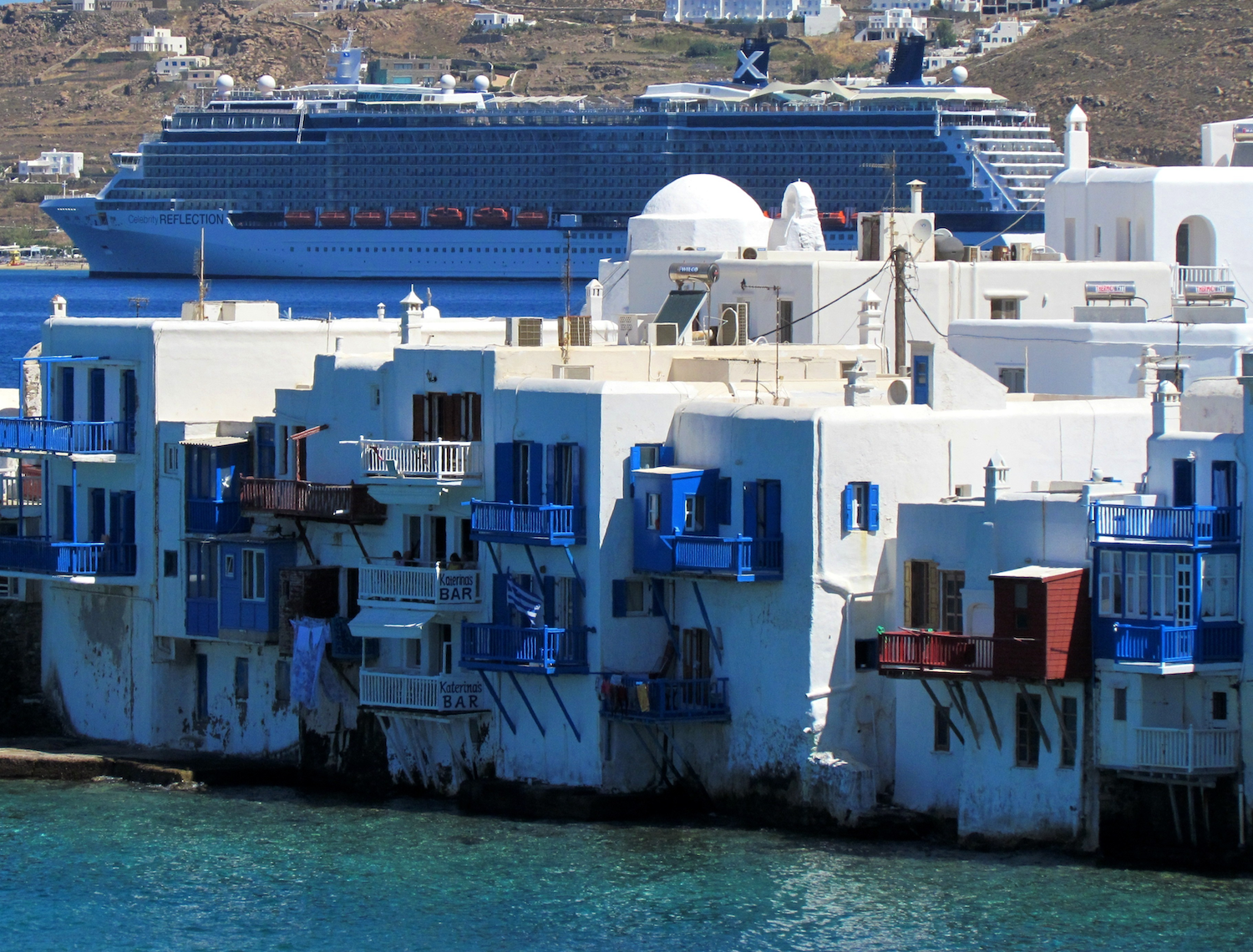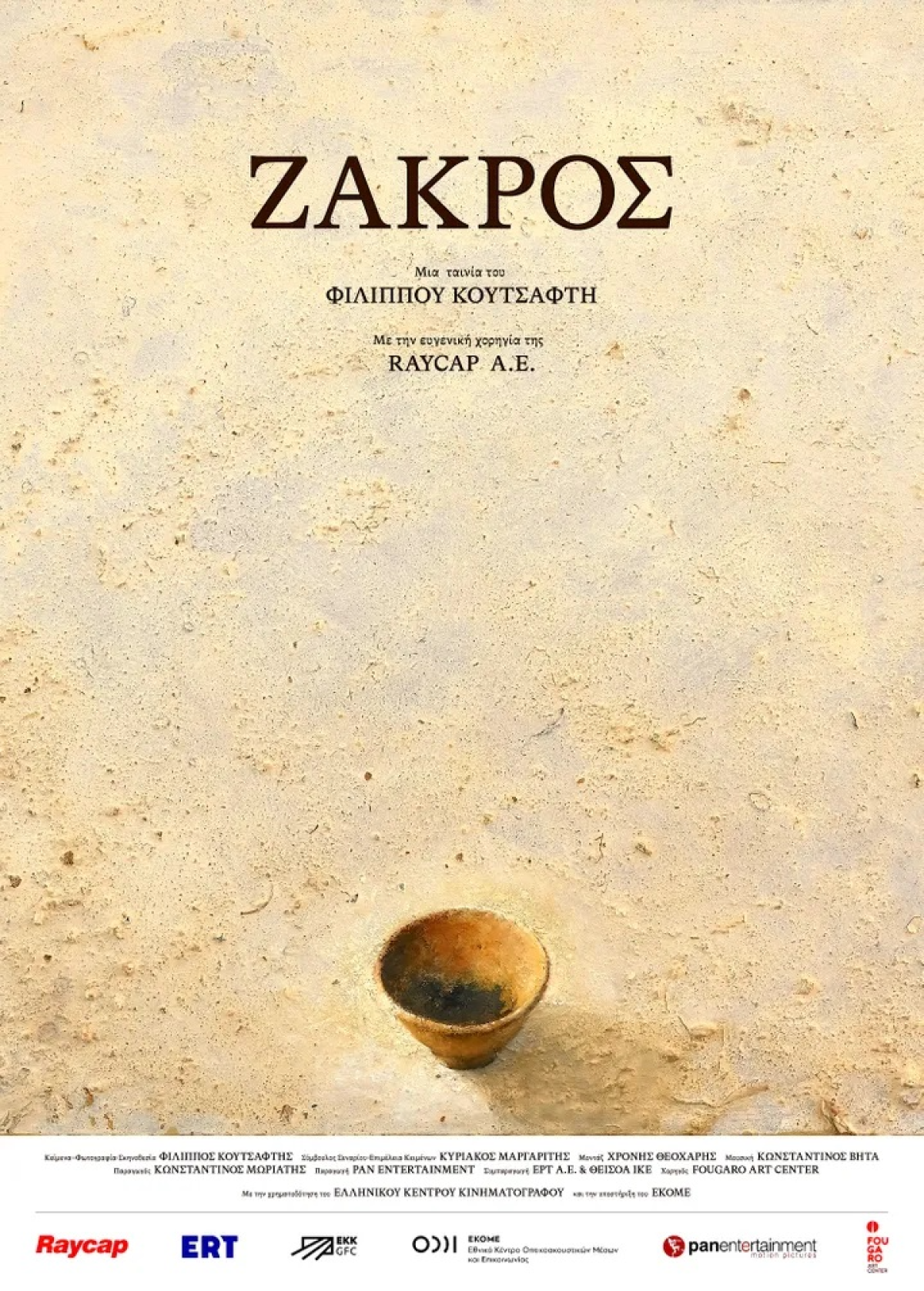Filippos Koutsaftis’s Zakros:
Communal Memories of the Past, and the Present We’d Rather Forget
15 March 2023
Dimitris Plantzos National and Kapodistrian University of Athens
Zakros, the recently released new film by Filippos Koutsaftis, is a welcome revisiting of a familiar territory charted by Greece’s most prominent documentary film-maker: contemporary Greece as an archaeological landscape in the present.
In the film’s 97΄ minutes, we follow a team of archaeologists, led by Nikolaos Platon (1909-1992), one of the country’s leading prehistorians, excavating on Zakros, a site on eastern Crete. Koutsaftis filmed the progress of the excavation over a span of several decades, from the 1980s to the present (following Platon’s death, the project is now led by his son, Eleftherios, also appearing in the film at various stages of his life). At the same time, and in Koutsaftis’s trademark style, we observe life in the nearby village, “a small mark on the map”, according to the film’s blurb, “light and wind-spattered”, as the film “glimpses and attempts to navigate the labyrinths of time, history, memory, and everyday life”. Following the film-maker’s by now long established method – displayed already in his early works such as the short films Modest Goddesses from 1987 and One Day with Minos from 1988 (the latter also centring on Zakros and its archaeology) – in the new movie, too, Greece’s cultural past is explored as an ever-living presence for the country’s people, and thus the filmic process is deployed as an archaeology of memory: sensorial as well as emotive.

Figure 1. Filippos Koutsaftis, Zakros (2023). Official poster.
Zakros follows on the steps of Koutsaftis’s magnum opus, Mourning Rock (2000), focusing on the archaeology and contemporary life of the town of Elefsina, home of the classical site of Ancient Eleusis. Structured as a personal, and often esoteric, contemplation of the clash between natural and built environments, the film laments what its maker understands as the town’s degeneration from a sacred classical landscape dedicated to Demeter, goddess of fertility, to a forcibly modernized Greek dystopia housing shipyards, oil refineries, unsightly blocks of flats, and a thoroughly westernized way of life. Narrated by the director himself (a practice he has since resumed in all his films), Mourning Rock offers its maker’s commentaries on the images shot and the events narrated, often adding behind-the-scenes asides on, for example, certain technical aspects of a shot, or the difficulties faced on a particular day on location. His films thus become journals of their own filming, reminiscent of the way in which an excavation daybook is supposed to document archaeology’s progress – as well as its limitations. When filming archaeologists in action (and this is particularly evident in Zakros, too), the camera dwells on their small and often unassuming finds as they are being salvaged by their careful hands. As I have had the chance to argue before, in his films the classical past is seen to retain its lost materiality, as archaeology manages to reconnect collective notions of national history to the past’s lost tangibility. This rediscovered materiality of the past reinforces its metaphysical grip over the nation’s collective imaginary, here enabled through the popular medium of cinema.
As I have also shown in my earlier work, Koutsaftis’s films borrow considerably – as well as creatively – from the extended archive of Modern Greek metaphysics of national belonging, from the poetry of Seferis and Elytis, and most emphatically, the cinematography of Theo Angelopoulos. His non-linear perceptions of time and space generate, in my view, particular, utopian spatialities that defy our standard Western cosmology of integral, essentialized space. Koutsaftis’s spaces – archaeological or everyday – are imagined as multi-modal sites, transcending the temporal divide and recreating historical time as a present – or indeed timeless – experience.
Zakros is a welcome revisiting of Koutsaftis’s “archaeology of contemplation”, recalling mostly his celebrated Rock I mentioned already and his short TO.RA.KE, released in 2007 to be part of the permanent exhibition at the new archaeological museum in Nafplion, in North-Eastern Peloponnese. If the Rock dwelled on a post-industrial Greek town overwhelmed by its classical heritage, and TO.RA.KE (the title refers to the way the word “thorax” – breastplate – was written in Mycenaean Greek) explored modern life in a Greek village where a significant archaeological find was once made, Zakros centres on the so-called “Minoan” heritage of Crete – invented as well as imagined – and the ways it intersects with the lives of the island’s present inhabitants: “this is where the Minoans lived; this is where we all live”, the director is heard contemplating early on (00:08:54). Koutsaftis seems, once again, thrilled by what he sees as cultural continuity (“watching the procession [i.e. of modern pilgrims to a countryside chapel], you get the feeling that this is how it always was; since the beginning of time”; 00:46:58), and even the geo-natural connections between the various stages of Greekness (metaphysical if not biological): “Looking for a fisherman of our times, whom we could compare to the Minoan inhabitant of House N (one of the site’s centrepieces), this could be no other than Antonis; they both used to fish in the same sea” (01:03:49-53).
“The grandeur of the everyday […] on the edge of Europe” (00:49:04): Koutsaftis’s systematic readings of Greek cultural continuity, and his calculated, as well as affective, portrayal of Greek time as a non-linear, embodied and sensorial mystical experience, set a persistent paradigm for a widely accessible archaeological metaphysics, channelling earlier ideas on Greek exceptionalism and the significance of the past into popularized notions of cultural identity and national belonging: “merry are those who wore the cloth ribbons against the wind like a crown”, we hear early on in Zakros (00:03:44), as we watch a band of schoolkids participating in an on-site class on “King Minos and Crete”, where they are asked to dress and perform as their primeval, “Minoan” selves.
As chance would have it, the general release of Zakros through the website of the Thessaloniki Film Festival coincided with the violent attack, on March 7, against Greek archaeologist Manolis Psarros, member of the permanent staff of the Greek Archaeological Service, stationed in the Cyclades, on the island of Mykonos. As made known by the Union of Greek Archaeologists (SEA), Psarros, who was severely injured and hospitalized for several days after the attack, was in charge, as part of his duties, of monitoring a number of land exploitation and real estate development projects on the island, mostly for the building of hotels or other tourism-related ventures. According to reports in the Greek press, the Archaeological Service have linked the attack to clandestine building activities in areas of archaeological interest, and especially two “entertainment centres” on the island’s beaches, which are under the scrutiny of the planning authorities, according to the provisions of the Greek laws for the protection of natural and cultural patrimony. As SEA, as well as SEKA, the Union of Archaeologists on Temporary Contracts, and others report, real estate and land development on Mykonos and the rest of the Cyclades (notably Santorini) has been running reckless for many decades now, often disregarding state laws and those entrusted with their enforcement. Previous attacks against municipal and state personnel, such as archaeologists or urban planners entrusted with the protection of built and cultural environment, have also been reported.

Figure 2. Cruise ship in the new port of Mykonos (2013). © Dimitris Plantzos.
The harsh deregulation of tourism industry in Greece during the recent pandemic, following several years of growth and expansion between 2013-2019, has seemingly necessitated the improvement of the country’s infrastructure, which invariably meant uncontrolled development within the country’s urban centres as well as its countryside. Laws ostensibly introduced to protect cultural patrimony and effect climate stability have been proven to achieve anything but: as recently as 2022, the World Wide Fund for Nature (WWF) stated that Greece’s policies towards environmental stability and conservation marked “one step forward, five back”. For it seems that a series of environmental bills and measures purportedly aimed at the protection of natural and cultural environment against unrestrained urban growth have in fact endangered both the country’s natural biodiversity and its monumental cultural heritage to an even greater extent. In July 2022, came an attempt by the Greek government to allow the opening of roads, the construction of touristic accommodations, parking spaces, sports activities and even allow mining, fishing and grazing in protected Natura 2000 areas and sensitive ecosystems across the country. The new bill was stopped at the last minute by the successful reaction of the parliamentary opposition, only to be reintroduced, if we are to believe a statement by the Minister for the Environment, “at some later date”.
At the same time, and in view of the steep rise in visitors’ numbers to the Acropolis, Greece’s top tourist destination, the Ministry for Culture proceeded to a seemingly rushed and makeshift “improvement” of public access to the site, which alerted many Greek and international observers, such as the UNESCO, as potentially harmful to the monument’s and the “sacred rock’s” cultural integrity.
It is within this climate of chaotic, disorderly, and ruthless expansion that, in view of the country’s overall touristification, attacks such as this against archaeologist Manolis Psarros must be seen: as the lethal throws of a corrupt system deeply embedded in Greek society – and even the country’s state apparatus – which, against what Koutsaftis portrays as the local communities’ idealized view of the past, sees cultural patrimony as a commodity of strictly monetary value, if at all.
“Man; a bundle of memories, made up from dozens of fragments” (00:25:28), muses Koutsaftis almost halfway through his latest film. Contrary to much of his earlier work, in Zakros the director constructs personal and communal time not as a linear trail through history as much as an elliptical trajectory through history-as-collective-memory. In one of the film’s most poignant sequences, we observe a present-day potter recreating the commonest pottery type in Bronze-Age Crete (a humble, small-sized cup): in a breath-taking leap of the imagination, Koutsaftis compares the elliptical, random traces of the technician’s tools on the bottom of the pot to the shape of Andromeda, the galaxy nearest to earth, seeing in both “the imprint of time” (00:12:00-13:00). Later on, Koutsaftis returns to the matter of macrocosm vs microcosm as the framework of human consciousness, concluding that the experience of history may be seen as the extraordinary, random balance between the “inconceivably great and the inconceivably small” (00:18:00-19:10); a world (“our” earth) whose measure remains the human gaze.
Perhaps somewhat influenced by the oeuvre of Chilean cinematographer Patricio Guzmán, Koutsaftis in Zakros contrasts the “inconceivably small” of archaeology to the “inconceivably great” of the cosmos in order to chart his personal quest for memory: “Those who hold on to memory are able to live in the fragile present time. Those without memory, do not live anywhere”, stated Guzmán who, like Koutsaftis, does his own voice-overs in his films, in the last, heart-breaking moments of his documentary Nostalgia for the Light (Nostalgia de la luz; 2010) which is justifiably considered his masterpiece (1:26:50-27:20). As we observe the nightscape of Santiago, the capital and largest city of Chile, studded with a multitude of flickering, star-like lights, we hear Guzmán’s esoteric, highly political and deeply historical address on time, trauma, and memory: “I am convinced that memory has a gravitational force; it is constantly attracting us”, he says, explaining why he endeavoured to make a film where archaeology, astronomy, and his country’s tormented past become entangled in a self-reflexive meditative soliloquy where the personal is reconfirmed as an integral part of the social and the corporeal is renegotiated as a representation of the abstract.
“Merry are those who treaded on this narrow path, on the tracks of the immortal mortals” (00:03:50): Koutsaftis’s Zakros, as well as his Rock, which preceded Nostalgia for the Light by a decade, frame beautifully Guzmán’s works, turning what might have been a strictly Greek exploration of historical memory as an archaeological experience, into global heritage. Contrary to Guzmán, who turned to moviemaking as a way to reconcile himself with his country’s turbulent political past, Koutsaftis only addresses violence in his films (especially the Rock and his early Modest Goddesses) as the mark of Greece’s swift and indiscriminate modernization in the post-war years. In dreaming of the past-ever-present as national history, however, both he and we, his devoted audience, have neglected to look at the driving forces behind Greece’s booming heritage industry in recent years, and the violence they unleash – both mental and factual.
For, by choosing to espouse Guzmán’s cosmology, Koutsaftis neglects to also adopt his politics, or any politics for that matter: for someone who spent the last four decades or so filming life in and nearby a desolate archaeological site on a remote Cretan coast, Koutsaftis has somehow managed to miss altogether the violence of industrial or tourist expansion (a topic well foregrounded in his Mourning Rock, for example), or the more recent economic recession and the effects of harsh austerity measures (as in his Hail Arcadia, from 2015). By promoting his own, and largely idiosyncratic aesthetics of continuity, Koutsaftis ends up avoiding politics altogether, thus undermining his own ideas on communal memory and its preservation – which are, nevertheless, inherently political.
References
Plantzos, Dimitris. 2018. “Crisis, austerity measures and beyond: archaeology in Greece since the global financial crisis”, Archaeological Reports 64, pp. 171-180.
-----2019. “Utopian spatialities: the past as present in the films of Philippos Koutsaftis”, Journal of Modern Greek Studies 37:2, pp. 327-360.

Dimitris Plantzos is Professor of Classical Archaeology at the National and Kapodistrian University of Athens. He writes on classical art and its modern receptions, archaeological theory, and the uses of antiquity in contemporary political discourse. He is the author of Greek Art and Archaeology and The Art of Painting in Ancient Greece, both published by Kapon Editions in Athens, Greece and Lockwood Press in Atlanta, Georgia in 2016 and 2018 respectively, and: The Archaeologies of the Classical. Revising the Empirical Canon (Eikostos Protos Editions, 2014); The Recent Future. Classical Antiquity as a Biopolitical Tool (Nefeli Editions, 2016), and Archaeopolitics (Eikostos Protos Editions, 2023). A collection of his writings may be accessed through his Academia.edu page.
